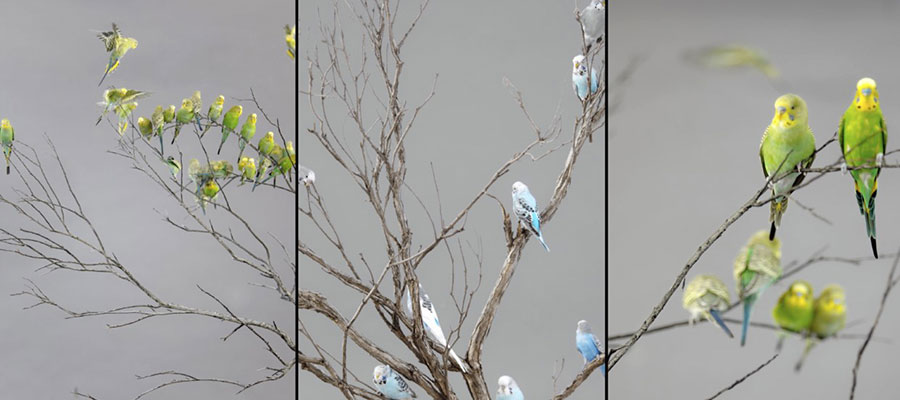NATURE IS NOT A PLACE TO VISIT. IT IS HOME.

Snow-white budgerigars, wings flapping joyfully, glide through the air to alight on the surface of a burnt, black tree. A sun-yellow flock flies across a triptych with liquid grace, airborne bodies recalling falling leaves. As the music grows slower, more plaintive, the camera focuses in on a bird. It shakes its head from side to side, feathers rippling in the breeze. The subject is unmistakably avian, but the gesture is pure human. The bird’s life and our life are connected, shaped by shared cycles of loss, grief and renewal. Its home among the trees is the place we belong, too.
Nature is not a place to visit. It is home (2019) is a three-channel video work that marks a radical shift for Leila Jeffreys. The work, among Jeffreys’ most ambitious and technically demanding, represents a change in direction for the artist. It’s a pivot away from the intimate portraits of birds that have defined the first ten years of her practice and towards the symbiotic relationship that exists between birds and their habitat. The work also draws a parallel between the bonds that exist between humans, the way actions can shape collective behaviour and the intimate dynamics of the flock.
Nature is not a place to visit. It is home. shares a lineage with Japanese artists of the 16th and 17th century, whose exquisite Byōbu folding screens celebrated the connection between culture and nature. But at its heart it’s a love letter to the Australian bush. Its portrayal of the fleeting and precious nature of our ecosystem, the complex connections that exist between animals and their environment also foreshadowed Australia’s bushfires, which have claimed the lives of more than one billion native birds, mammals and reptiles. The work has taken on the mood of an elegy. But it’s also an ode to beauty, a call towards encountering the wonder of the natural world and its power to inspire individual gestures of protection. These actions might be small but have a cumulative impact. They can help us sustain hope.
In her 1955 book The Sense of Wonder, the writer and conservationist Rachel Carson made a case for paying attention to nature. She urged us to ask ourselves: “What if I had never seen this before? What if I knew I would never see it again?” Nature is not a place to visit. It is home. delves deeper into Jeffrey’s long-time belief that to see ourselves as part of a world that nurtures both the human and the non-human, to pay attention to the flying creatures around us, is a form of love. And once we acknowledge the force of that love, we have no choice but to do everything we can to conserve it.
Nature is Not a Place to Visit. It is Home by Leila Jeffreys was shown on the Peel Street Park Projector from 19 October to 7 December, 2020
Image: Leila Jeffreys 'Nature is not a place to visit. It is home' 2019. Multiple-channel digital video, looped, 8 mins 26 sec, dimensions variable, edition of 8 + 2AP. Courtesy of Olsen Gallery, Sydney; Purdy Hicks Gallery, London; and in association with This Is No Fantasy, Melbourne.
